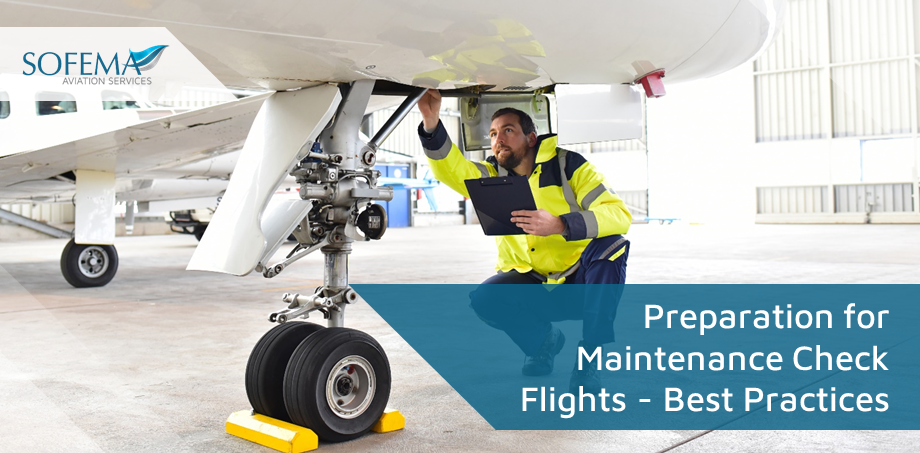Sofema Aviation Services (SAS) www.sassofia.com considers best practice activities in preparation for Maintenance Check Flights
Introduction
In order to understand the work completed on the aircraft, a thorough briefing with the maintenance personnel/facility that has completed the work is of extreme importance.
- The type of flight and depth of testing should then be agreed upon with all parties involved.
- It is also of great importance that once an agreement has been reached, the flight should be completed as agreed, with no deviations, additions or changes. If required, additional flights should be performed.
- The preflight checks assume that all necessary documentation has been properly completed and reviewed and the aircraft has been released for flight.
Note: To use this information to compare with the provided work pack Maintenance Instructions to support Flight Test Preparation
The following documentation may be required
- Certificate of airworthiness (if applicable)
- Aircraft flight release
- Special flight permit/RSI (restriction and/or special instruction) or equivalent (if applicable)
- RVSM operations letter of authority
- Weight and balance
- Maintenance logs (airspeed table, compass swing, RVSM altitude table, etc.)
- NCR (non-conformance report) or equivalent
- Aircraft configuration data
- Aircraft manuals (AFM, etc.)
- Confirmation that all return-to-service items are complete.
- Exterior Checks
- To confirm the condition of the aircraft, a thorough walk-around is necessary. In addition to the standard
- walk-around items, extra checks should be included in the plan.
- Exterior checks walk-around will ensure the condition of the following:
o Proximate area free of potential FOD
o No covers installed
o All vents, intakes and exhausts unobstructed
o Flight control surfaces and structures are clear, not damaged or missing, with no leaks
o All probes, ports and vents are clear and not damaged
o Pitot and static probes and surrounding areas are clear with no wrinkles
o All critical surfaces are clear of contamination
o No fluid leaks from components, drains and panels, airplane skin condition
o Gear struts with proper extension, no leaks
o Tires and brakes acceptable condition for flight
o Engines inlet and exhaust are clear, panels secured, and reversers stowed
o APU inlet and exhaust are clear, panels secured
o All doors and panels not in use are closed and latched
o Antennas not damaged and not inadvertently painted
o External lights clean with no damage
Threats
- Use of clear tape to cover vents. Damage to probes due to stepping or impact from ground staging.
- Length of time since last flight.
- Additional items should include:
o Batteries, condition and secure
o Engine fire bottles, pressure and condition
o APU Fire bottles, pressure and condition
o Cargo compartment smoke detectors, condition
o Hydraulic system accumulators, normal pressure and pre-charge
o Brake accumulators, normal pressure and pre-charge
o Fuel panel check (fuel quantity)
o Check for FOD in all access areas (cargo compartments, avionics bays, wheel wells, etc.)
o Oxygen bottle, pressure and condition
o Circuit breaker panels located away from the cockpit (as applicable to aircraft type)
o Avionics bay
o Equipment bay
- All equipment that has been identified in the maintenance logs has been serviced and/or replaced
- No loose equipment in the cargo compartment.
- Threats – FOD
- Interior Checks
o The cockpit and cabin interior checks will ensure the condition of the following:
o Cockpit emergency equipment to include flashlights, fire extinguishers, crash ax, protective breathing equipment (PBE), life vests
o Cabin emergency equipment to include flashlights, fire extinguishers, PBE, life preservers, life rafts (if available), door slides (if equipped), megaphone (if installed), first aid kit (if required)
o Circuit breaker panels closed or collared (if applicable)
o Main door(s), service door(s) and all emergency exits functional.
o Flight deck, flight crew, and flight attendant seats operate normally
- Ballast (if required) secured
Next Steps
Follow this link to our Library to find & Download related documents for Free.
Sofema Aviation Services is pleased to provide the following course as Classroom or Webinar training: Managing EASA Maintenance Check Flight (MCF) and Permit to Fly (PtF) Requirements – 1 Day
If you need more details about our services, please see www.sassofia.com or email us at team@sassofia.com
Tags:
Aircraft, Aircraft Maintenance, aviation, EASA, Airworthiness, RVSM, Aircraft Weight and Balance, SAS blogs, Certificate of Airworthiness, Cabin Interiors, Flight, Fire Extinguisher, Flight Test, Maintenance Check Flight (MCF), acceptable condition for flight, protective breathing equipment (PBE)




